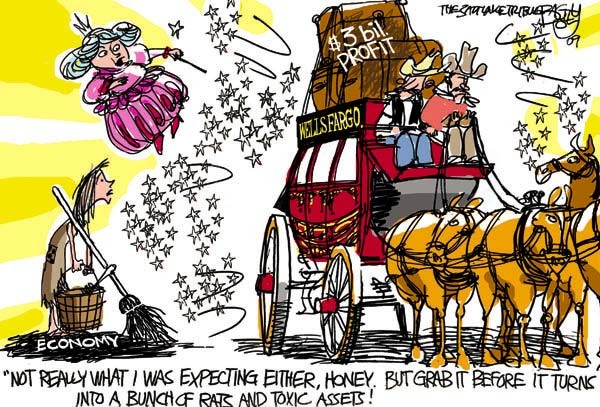Bernanke Bet on Keynes Has Meltzer Seeing 1970sStyle Inflation
Post on: 26 Июль, 2015 No Comment

Ben Bernanke, chairman of the U.S. Federal Reserve
April 13 (Bloomberg) — Federal Reserve Chairman Ben S. Bernanke is siding with John Maynard Keynes against Milton Friedman by flooding the financial system with money.
If history is any guide, says Allan Meltzer. the effort will end in tears. Inflation “will get higher than it was in the 1970s,” says Meltzer, the Fed historian and professor of political economy at Carnegie Mellon University in Pittsburgh. At the end of that decade, consumer prices rose at a year-over-year rate of 13.3 percent.
Bernanke’s gamble that the highest jobless rate in 25 years and the most idle factory capacity on record will hold down inflation is straight out of the late British economist Keynes. Should late Nobel-prize-winner Friedman’s dictum that “inflation is always and everywhere a monetary phenomenon” prove right, the $1 trillion or more in liquidity Bernanke has pumped into the financial system by expanding the Fed’s balance sheet may leave him to cope with surging consumer prices.
So far, investors and economic data both back up the Bernanke-Keynes view. The market in Treasury Inflation-Protected Securities as of April 6 indicated long-term inflation expectations of 2.5 percent, below the 2.8 percent average inflation rate of the past 10 years.
Figures to be published April 15 will probably show that the March consumer price index was unchanged from a year earlier, thanks to a steep decline in energy costs, according to economists surveyed by Bloomberg News. In February, the index rose at a year-over-year rate of just 0.2 percent.
Increasing Expectations
Still, the 2.5 percent expectation represents an increase from 2.1 percent at the end of last year. And Meltzer, 81, who has written an 800-page history of the Fed’s first 38 years and is now working on volume two, isn’t alone in seeing a return of sky-high inflation as a result of Bernanke’s policies.
John Brynjolfsson. chief investment officer at hedge fund Armored Wolf in Aliso Viejo, California, says the Fed is still in the early stages of its effort to pump up the economy.
“We’ve got at least nine innings of reflation ahead of us, ultimately ending with probably double-digit inflation,” he said in a Bloomberg Television interview on April 6.
Investors are starting to protect themselves from the risk of faster price increases by buying TIPS, pushing up the return on the securities to 6.1 percent in March, the best performance since the U.S. government introduced them in 1997, according to Merrill Lynch & Co. index data.
A Ballooning Balance Sheet
Behind investors’ caution: a ballooning Fed balance sheet that has climbed $1.2 trillion in the past year to $2.09 trillion and expanded the nation’s money supply. It is poised to increase even further after last month’s Fed decision to buy an additional $1.15 trillion worth of assets, including $300 billion in Treasury securities.
M2, a broad measure of the money supply that includes checking accounts and money-market mutual funds, rose in the last six months at an annual rate of 14 percent. That compares with an average 6.3 percent during the last decade.
Meltzer says political pressure will prevent Bernanke, 55, and fellow policy makers from withdrawing liquidity quickly enough as the economy recovers. That’s similar to the pattern that occurred back in the 1970s, he says. Then-Chairman Arthur Burns allowed excessive money-supply growth because he was unable or unwilling to resist pressure from President Richard Nixon’s White House to hold down unemployment, leading to the “great inflation” of that era, he says.
‘Squandered’ Independence
Now, Bernanke and fellow policy makers have “squandered their independence” by becoming involved in bailouts of financial firms and by taking long-term and illiquid assets onto their balance sheet, Meltzer says. “They don’t have the political ability to control inflation.”
John Ryding. founder of RDQ Economics LLC in New York and a former Fed economist, agrees that the central bank will be slow to soak up all the cash it has injected into the financial system, in part because policy makers will be fixated on still-high unemployment. The rate rose to 8.5 percent in March, compared with 7.2 percent in December.
“They pay lip service to inflation being a monetary phenomenon,” he says. “But they’re too much concerned with the Keynesian explanation of inflation.”
There are signs that the Fed’s stimulus — combined with the efforts of central banks and governments elsewhere in the world, including China — is starting to lift some commodity prices. Copper rose to a five-month high and platinum reached a six-month peak on April 9.
Oil Prices
“All that money is going to find a home,” says Ken Mayland. president of ClearView Economics LLC in Pepper Pike, Ohio. He sees oil prices increasing to “$80, $90, $100 before the end of next year” from $52 a barrel now.

Commodity prices may be more prone to rise as the world economy recovers because tight credit and volatile pricing will discourage investment in new supplies, says Mark Zandi. chief economist at Moody’s Economy.com, in West Chester, Pennsylvania.
Chesapeake Energy Corp. of Oklahoma City, and Houston-based Carrizo Oil & Gas Inc. are among energy producers that are limiting spending and curbing drilling after a collapse in credit markets drove up debt costs.
Some Fed policy makers seem more worried about deflation than they do about inflation. A sustained fall in prices can debilitate the economy by causing consumers and businesses to postpone purchases.
“For some time to come, disinflation, and even deflation, will represent greater risks than inflation,” San Francisco Fed President Janet Yellen said in a speech on March 25.
Below Potential
At the root of that concern is substantial and growing slack in the economy, which, according to White House chief economist Christina Romer. is operating 5 percent to 10 percent below potential. That means the economy will have to grow a percentage point above trend — reckoned by the administration to be about 2.5 percent annually — for five or more years before the slack is used up.
The Phillips curve — developed by economist A.W. Phillips using Keynesian concepts — posits that such excess will reduce inflation as firms stuck with idle capacity cut prices and workers facing layoffs accept smaller wage hikes.
Not everyone at the Fed buys into that argument. Noting that some economists forecast substantial slack will keep inflation low for several years, Richmond Fed President Jeffrey Lacker said in a March 26 speech that he would be “cautious about relying on this correlation.”
The Fed is “running a laboratory experiment” on what drives inflation: the money supply or the output gap, says Laurence Meyer. a former Fed governor and now vice chairman of St. Louis-based Macroeconomic Advisers
“How it turns out will do a lot to influence the economic debate,” he says, adding that his money is on Bernanke.
To contact the reporter on this story: Rich Miller in Washington o rmiller28@bloomberg.net
To contact the editor responsible for this Chris Anstey at canstey@bloomberg.net














